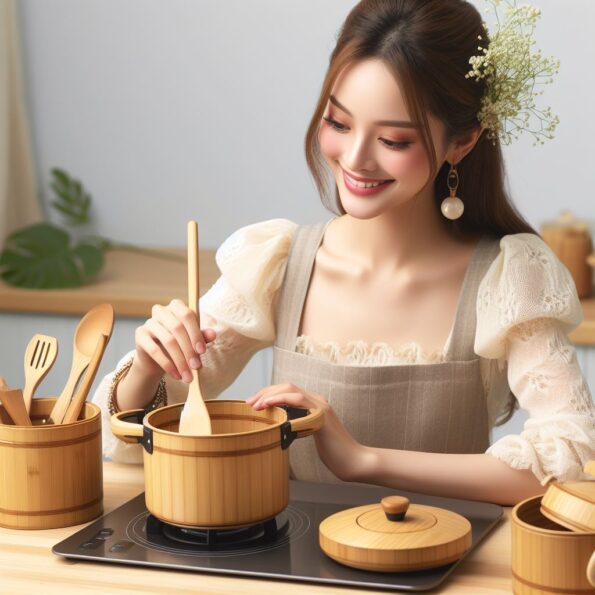Bamboo kitchenware is gaining popularity as a sustainable and eco-friendly alternative to traditional utensils and cookware. From cutting boards to spatulas, bamboo offers several benefits that can enhance your cooking experience while minimizing your environmental impact.
Bamboo is a fast-growing grass that requires minimal water and no pesticides to thrive. Unlike hardwood trees, which take years to mature, bamboo can be harvested within a few years. Choosing bamboo kitchenware helps reduce deforestation and promotes sustainable practice.: Bamboo utensils are lightweight yet sturdy. They won’t scratch your non-stick pans or delicate cookware. Their durability ensures they’ll withstand daily use without splintering or warping.
Natural Antibacterial Properties: Bamboo contains natural antimicrobial compounds that inhibit the growth of bacteria and fungi. This makes bamboo cutting boards and utensils hygienic and safe for food preparation. Heat Resistance: Bamboo kitchenware can handle high temperatures without warping or melting. You can confidently use bamboo spatulas, ladles, and tongs while cooking.
The Sustainability of Bamboo Kitchenware
Bamboo kitchenware offers a sustainable and eco-friendly alternative to traditional wood and plastic utensils.
Let’s explore its environmental benefits:
- Eco-Friendly Material:
- Fast Growth: Bamboo is a type of grass that grows rapidly, reaching maturity in just a few years. Unlike hardwood trees (such as oak or maple), which take decades to mature, bamboo can be harvested within 3 to 5 years.
- Minimal Water and Pesticides: Bamboo requires less water and no pesticides for cultivation. Its natural resilience makes it an excellent choice for sustainable kitchenware.
- Harvesting and Regeneration:
- Renewable Resource: When bamboo is cut, it regenerates from the same root system, eliminating the need for replanting. This continuous growth cycle ensures a steady supply without depleting natural forests.
- Selective Harvesting: Bamboo can be selectively harvested, allowing other plants in the grove to thrive. In contrast, traditional wood harvesting often involves clear-cutting entire sections of forests.
- Reduced Environmental Impact:
- Carbon Sequestration: Bamboo absorbs more carbon dioxide (CO₂) than hardwood trees, making it an effective carbon sink. Planting bamboo helps mitigate climate change.
- Soil Health: Bamboo’s extensive root system prevents soil erosion and improves soil quality.
- Habitat Preservation: Choosing bamboo over traditional wood reduces pressure on old-growth forests and protects wildlife habitats.
- Health and Safety:
- Antibacterial Properties: Bamboo naturally contains antimicrobial compounds, making bamboo cutting boards and utensils resistant to bacteria and fungi.
- Chemical-Free: Unlike some plastics, bamboo kitchenware doesn’t leach harmful chemicals into food.
Health Benefits of Bamboo in the Kitchen
Antimicrobial Properties of Bamboo: Bamboo possesses natural antimicrobial properties, making it an excellent choice for kitchenware. These properties stem from a compound known as “Bamboo Kun”. This substance helps repel bacteria, fungi, bugs, and pests, contributing to a hygienic kitchen environment. When using bamboo cutting boards or utensils, you benefit from this inherent protection against harmful microorganisms.
Safety of Bamboo Utensils: Bamboo utensils are generally safe for everyday use. Here’s why:
- Non-Toxic: Bamboo is a natural material that doesn’t contain harmful chemicals. Unlike some plastics, it won’t leach toxins into your food.
- Durable: Bamboo utensils are sturdy and won’t crack under pressure. They’re suitable for everyday cooking and stirring.
- Heat Resistant: You can confidently use bamboo utensils at high temperatures during cooking.
- Easy to Clean: Handwashing bamboo utensils is recommended. While they are dishwasher-safe, handwashing extends their lifespan and prevents potential damage from dishwashing cycles.
Nutritional Advantages of Bamboo Shoots: Bamboo shoots offer several health benefits:
- Low in Calories: One cup of cooked bamboo shoots contains only 64 calories.
- Rich in Fiber: They provide 2 grams of fiber per serving, aiding digestion and promoting regularity.
- High in Copper: Essential for skin health and brain function.
- Source of Vitamin B6: Vital for various biochemical reactions in your body.
- Antioxidant Vitamin E: Protects against inflammation and chronic diseases.
- May Reduce Cholesterol: Some studies suggest that bamboo shoots can lower cholesterol levels, benefiting heart health.
- Other Potential Benefits: These include antihyperglycemic, anti-inflammatory, and immunomodulatory properties.
Benefits of Bamboo Kitchenware
- Rapid Growth and Renewability:
- Bamboo is a renewable resource that grows quickly. It’s one of the fastest-growing plants on the planet.
- Unlike hardwood trees that take decades to mature, bamboo can be harvested at a much quicker rate.
- When you cut down a bamboo stalk, another one sprouts up, maintaining soil health and preventing erosion.
- Biodegradability:
- Bamboo is biodegradable, meaning it naturally decomposes after use.
- Unlike plastic, which lingers in landfills for hundreds of years, bamboo returns to the earth without harming the environment.
- It’s also compostable.
- Safe for Food Use:
- Bamboo doesn’t contain toxic substances that could leach into your food.
- Unlike some plastic utensils, bamboo won’t release harmful chemicals when exposed to hot food or drinks.
- Long-Lasting:
- With proper care, bamboo cutlery can last for years.
- This makes it a cost-effective option compared to disposable plastic utensils that you have to replace after one use.
- Lightweight and Easy to Clean:
- Bamboo cutlery is lightweight, making it easy for everyday use.
- Cleaning is a breeze: wash it by hand with warm, soapy water and air dry.
- Unlike metal cutlery, bamboo won’t scratch your cookware.
- Aesthetic Appeal:
- Bamboo has a natural, organic look that adds elegance to any kitchen or dining table.
- Its unique texture and appearance make it a stylish choice.

Types of Bamboo Kitchenware
- Bamboo Utensils:
- Bamboo utensils include spoons, spatulas, and chopsticks.
- They are versatile, lightweight, and comfortable to use in daily cooking.
- Bamboo utensils are a great alternative to plastic or metal options.
- Bamboo Cutting Boards:
- Bamboo cutting boards are known for their durability.
- They have a knife-friendly surface that won’t dull your blades.
- Additionally, bamboo has natural antimicrobial properties, making it a hygienic choice for food preparation.
- Bamboo Bowls and Plates:
- Bamboo bowls and plates are lightweight and easy to handle.
- They are eco-friendly, as bamboo is a sustainable material.
- These bowls and plates enhance the dining experience with their natural look and feel.
How do I care for bamboo cutting boards?
Proper care for bamboo cutting boards ensures their longevity and maintains their appearance.
Follow these steps to keep your bamboo cutting board in top condition:
- Cleaning:
- After each use, hand wash your bamboo cutting board with warm water and mild soap (such as Dr. Bronner’s Organic Soap).
- Use a natural bristle brush to scrub the board clean.
- Rinse thoroughly and air dry or towel dry completely before storing it.
- Disinfecting:
- To disinfect, use pure white vinegar. Wipe the board with vinegar using a cloth, then rinse with water.
- Alternatively, mix one teaspoon of bleach with two quarts of water for stronger disinfection.
- For a natural option, use lemon juice and salt to lift stains and leave the board smelling fresh.
- Oiling:
- Apply mineral oil directly to the surface of your board.
- Rub it in using a cloth and let it sit for a few hours or overnight.
- Oiling once a month is sufficient for regular use; more often for less frequently used boards.
What are some common mistakes to avoid when caring for bamboo cutting boards?
- Dishwasher Use:
- Do not clean your bamboo cutting board in the dishwasher.
- Extended exposure to moisture and heat may cause warping or cracking.
- Harsh Chemicals:
- Avoid using harsh chemicals, such as bleach, on bamboo.
- Stick to gentle, natural cleaning agents.
- Soaking in Water:
- Do not soak your cutting board in water for extended periods.
- Prolonged exposure to water can damage the bamboo.
- Inappropriate Oils:
- Use oil specifically made for bamboo when finishing your board.
- Natural cooking oils (like olive, canola, or walnut oil) should not be used on bamboo.
Conclusion
Bamboo is a renewable resource that grows quickly and doesn’t require replanting. By choosing bamboo kitchenware, you reduce your environmental impact compared to plastic or metal alternatives. Bamboo has inherent antibacterial properties, making it resistant to microbial growth. This is especially beneficial for cutting boards and utensils, as it helps maintain hygiene in the kitchen.
Bamboo kitchenware is lightweight yet sturdy. It won’t scratch non-stick pans or delicate surfaces, making it ideal for everyday cooking tasks. Bamboo can withstand high temperatures without warping or melting. You can use bamboo utensils for stirring, flipping, and serving hot dishes without worry.
Bamboo’s natural grain and warm color add a touch of elegance to your kitchen. From utensils to bowls and cutting boards, bamboo items enhance the visual appeal of your cooking space. By opting for bamboo, you contribute to reducing plastic waste. Bamboo products are biodegradable and compostable, unlike plastic alternatives that persist in landfills. In conclusion, incorporating bamboo kitchenware can revolutionize your cooking experience with its eco-friendly and durable qualities. Explore the benefits and make the switch today with The Amrit Life.











